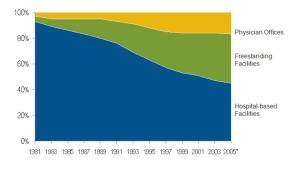Volume trends in US healthcare – Shift from hospital to non-hospital settings
Over the past five years, hospital inpatient and outpatient admissions are growing at a much smaller rate than non-hospital based outpatient services. A clear case in the point being outpatient surgeries. Increasingly, outpatient surgeries are moving to non-hospital based settings, taking with them the observation, follow-up and possibly some Med surg volumes (see below)
Competition for Market share
The current payment system is also fuelling this trend, as it gives non-hospital providers an advantage in that they are able to focus on most profitable services (such as opthamalogy). While, hospitals face a higher cost structure to support unprofitable but essential services (such as inpatient psychiatric units). In metro areas like Houston, for instance small, ful service facilities are springing up as a result of joint ventures between physicians and Wall street based venture capital funds.
This means now more than ever, traditional hospitals need to have strategies in place to fight for market share with these free standing centers.
5 Strategies for maintaining and growing volume
1. Increase outpatient services capabilities to compete on equal footing with freestanding ASCs
2. Consolidate core programs to better withstand market competition – Build strong programs in profitable areas such as thoracic surgery, ENT and Oncology
3. Integrate physicians into strategic planning, management and governance – A close analysis of the freestanding ASC type centers reveals over 60% of these facilities are developed by physicians or physicians in conjunction with another entity.
4. Build in Quality and increase it’s visibility – Do what Toyota did in the auto industry. Drive process and quality improvement and build your hospital brand around these initiatives and outcomes (Eg: Lowest infection rates in the city).
5. Invest in and utilize Business intelligence – To stay ahead of the curve you need to know, where you are in relation to your competition so continuously and rigorously measure and feedback business intelligence to your managers and administrators


